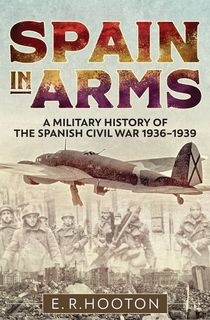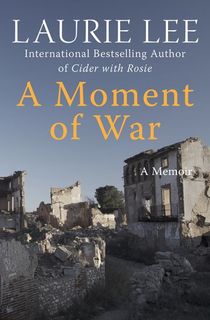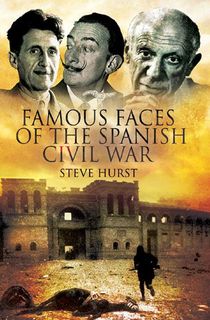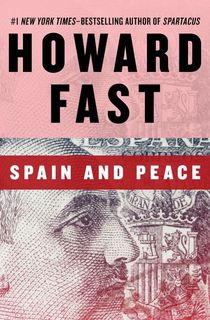From 1936 to 1939, Spain was divided by an explosive civil war. In the wake of a military coup staged by the right-leaning Nationalist faction, General Francisco Franco led the party in a revolt against the left-leaning Republicans who were ruling over the newly-established Spanish Republic. This staggering confrontation was viewed from various perspectives in the global arena, ranging from a class struggle to a battle between fascism and communism.
One thing is certain: the repercussions of this violent conflict lasted decades beyond the end of the war itself. Up to 200,000 people were killed both in battle and in the years of brutal repression that followed the Nationalist victory. The war also paved the way for Franco's 39-year dictatorship, an era characterized by both authoritarianism and economic prosperity. If you're looking to learn more about this period in history, here are eight illuminating Spanish Civil war books that examine the conflict from every angle.

Spain in Arms
This detailed military account provides an examination of eight Spanish Civil War campaigns. Shedding light on half-truths and propaganda, E.R. Hooton provides an in-depth analysis of what really happened on the battlefields—from the Madrid Front to the Catalonia Offensive. Paying special attention to weaponry and tactics, this work portrays the moment-to-moment decision making going on between the Republicans and the Nationalists. Pulling from German, Russian, and Italian sources, this illuminating Spanish Civil War book cracks open a trove of military history.

A Moment of War
This gripping memoir of a Spanish Civil War soldier tells the tale of a young man who crawled back home to join the Republican cause after being driven away by Nationalists. But though Laurie Lee volunteered to fight with the idealism of youth, the reality of war was soon brutally laid out before him. The International Brigades were not as polished and skilled as they first appeared, and paranoia, bad food, and boredom were as pervasive as the bloodshed that came with war. And when it finally came time for Lee to engage in battle, the fight he was so eager to join left him feeling less than heroic.

Famous Faces of the Spanish Civil War
In this moving historical text, notable writers, artists, and musicians who were entangled deeply in the tragedies of the Spanish Civil War recount the conflict. As the book chronologically winds its way through the progression of the war, readers are treated to observations from the likes of Ernest Hemingway, Pablo Picasso, George Orwell, Salvador Dalí, and more. Additionally, this book provides accounts from infamous spies, including Kim Philby and Anthony Blunt.
Related: FBI Surveillance: Why the Bureau Investigated Famous Writers

Spain and Peace
First published in 1951, this pamphlet gives an overview of what Spain was like under the rule of General Francisco Franco. Author Howard Fast was a firm supporter of Spain's antifascist movement, and appeals fervently in this text for readers of the time to reject American military agreements with Spain. This important historical document is a powerful denunciation of a Spanish dictator, from a man who supported a hospital for Popular Front forces and was sentenced to three months in jail for refusing to give the names of other supporters to the House Un-American Activities Committee.

The Life and Death of the Spanish Republic
This Spanish Civil War book told from the perspective of an eyewitness was first published by Daily Telegraph correspondent Henry Buckley in 1940. This work offers a unique perspective on Spanish politics, from the foundation of the Second Republic in 1931 to its fall in early 1939. As Buckley arrived in Spain before the outbreak of the conflict, he had a firm grasp on the culture, politics, and people of the area, giving him a closer look at the tragedies and a deeper respect for key players of the war.

Ghosts of Spain
Spaniards broke their "pact of forgetting" the painful memories of the Spanish Civil War when, 60 years after the end of the conflict, mass graves were discovered with the remains of people who fell victim to Francisco Franco's death squads. At this poignant moment in time, author Giles Tremlett set out on an expedition around the country to investigate why silence had reigned for so long.
Related: 10 Fascinating Ghost Towns Around the World You Can Visit

Revolution and the State
Author Danny Evans examines the radical anarchists who aimed to push their revolutionary agenda forward during the Spanish Civil War. These anarchists clashed with leaders of the Republican faction, who were committed to reconstructing the Second Republic after it nearly fell in 1936. Utilizing original sources, Revolution and the State shows how rebellious challenges to the Second Republic were both broader and more ideologically consistent than formerly assumed.

Comintern Army
The International Brigades were pro-communist military units that participated in the Spanish Civil War. In this in-depth study of Spanish Civil War politics, R. Dan Richardson examines the International Brigades within a broader context of the complex political-military alignments of left-leaning Spanish factions. Through use of an array of sources, Richardson argues that the Brigades were political, ideological, and propaganda machines that advocated for communism both at home and abroad.
Related: 12 Escapist Nonfiction Books That Will Spirit You Away
Featured photo of the surrender of Republican soldiers in the Somosierra area in 1936: Wikimedia Commons




